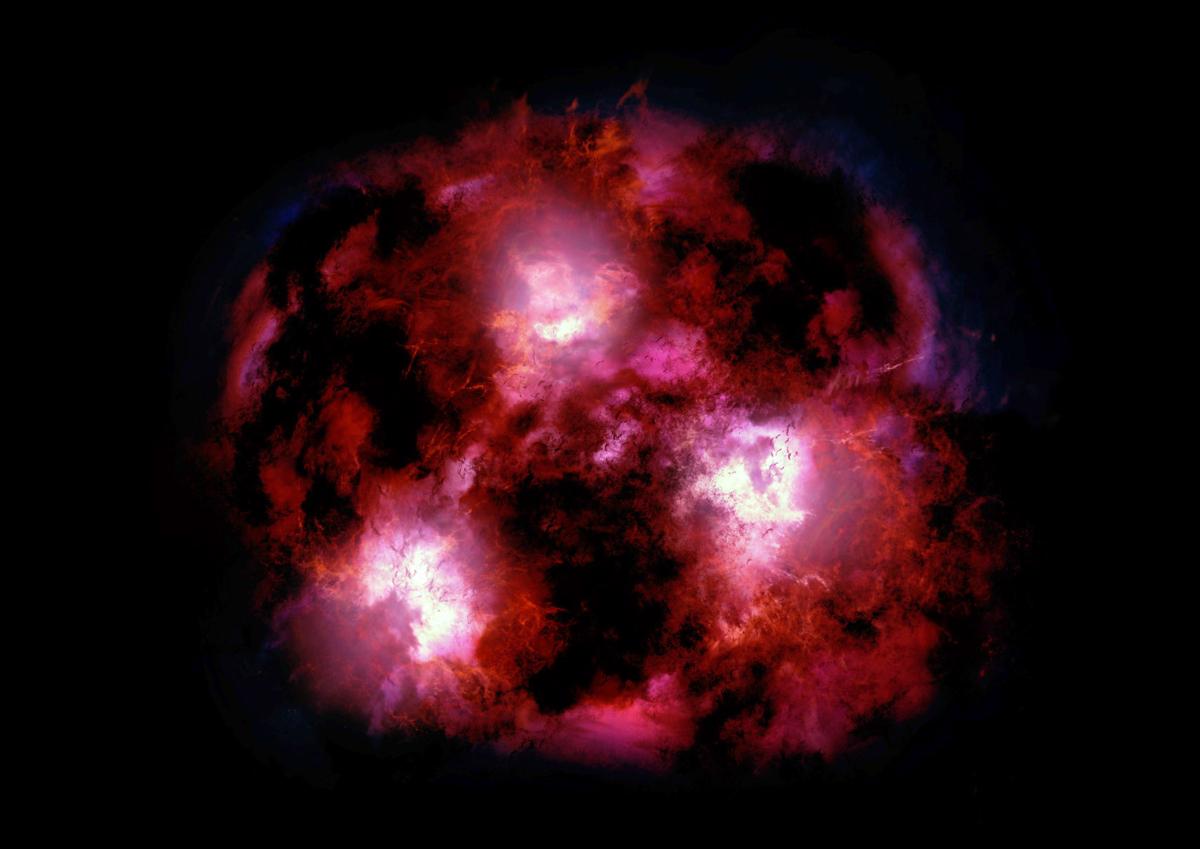A massive galaxy far, far away could be the key to unlocking some of the universe’s biggest secrets.
Earlier this year, University of Arizona astronomer Christina Williams stumbled upon an ancient monster galaxy that is forming stars at an unprecedented rate.
While gathering data for another project using the Atacama Large Millimeter Array, a collection of 66 radio telescopes in the Chilean mountains, Williams noticed a shimmering light in an area of the universe where nothing had been seen before.
“It was very mysterious because the light seemed not to be linked to any known galaxy at all,” said Williams, a National Science Foundation postdoctoral fellow at the Steward Observatory and lead author on the study published in the Astrophysical Journal. “When I saw this galaxy was invisible at any other wavelength, I got really excited because it meant that it was probably really far away and hidden by clouds of dust.”
Astronomers estimate that it took 12.5 billion years for the light from this galaxy to reach earth, making it a rare sighting of an ancient galaxy that formed less than 2 billion years after the Big Bang.
Williams and other researchers say this discovery is a lot like finding footprints to a “cosmic Yeti” because the scientific community generally regarded these types of galaxies as folklore.
“We figured out that the galaxy is actually a massive monster galaxy with as many stars as our Milky Way, but brimming with activity, forming new stars at 100 times the rate of our own galaxy,” said Ivo Labbé, study co-author at the Swinburne University of Technology in Melbourne, Australia.
The light Williams found was likely caused by the glow of dust particles that were heated by stars as they formed inside the galaxy. The giant clouds of dust build up and conceal the starlight, essentially making the galaxy invisible to astronomers. With the help of the telescope array, however, astronomers were able to detect a faint glow of light coming from the previously unknown galaxy.
“Stars form out of gas and we sort of already know that the early universe has a lot of gas in it,” Williams said. “So, we understand that galaxies at earlier times formed stars more rapidly than they do now, but this galaxy is really early in the universe. At this point, we don’t really understand how galaxies can form stars that quickly so early in the universe.”
According to Williams, astronomers believe this galaxy is actually at the end of its life cycle, because galaxies can only grow so big before they stop forming new stars.
Before this point, astronomers had no evidence of massive galaxies from the early universe as they formed. Recent studies found that some of the largest known galaxies had reached maturity very quickly — when the universe was only about 10% of its current age.
“We don’t really understand either of those things: why galaxies grow fast and why they stop,” Williams said. So, finding examples of that happening somewhere in the universe lets us figure that question out. It’s been known for a few years now that there’s a lot of those dead galaxies around in the early universe, and no one really had an explanation for where they came from because we’ve never been able to catch them as they’re forming.”
Now astronomers are hoping to determine how many of these massive galaxies actually exist in the universe. The observations for the current study were made in a tiny part of the sky.
“These otherwise hidden galaxies are truly intriguing; it makes you wonder if this is just the tip of the iceberg, with a whole new type of galaxy population just waiting to be discovered,” said Kate Whitaker, study co-author and assistant professor at the University of Massachusetts Amherst.
Williams said she and the team are not so patiently waiting for NASA’s James Webb Space Telescope to launch in 2021 because it will allow them to see past the dust and study the galaxy more effectively.
“That telescope is going to see in the infrared, which is an important part of the spectrum because it will be able to tell us things about the stars in that galaxy, which we can’t see right now,” Williams said. “When it launches, we’ll get a more complete picture of what this galaxy is and its formation history and I’m really excited about that.”
In the meantime, the team will continue using the Atacama array to search for more galaxies like this one, with hopes of finding more examples that can shed some light on these mysterious cosmic beasts.





